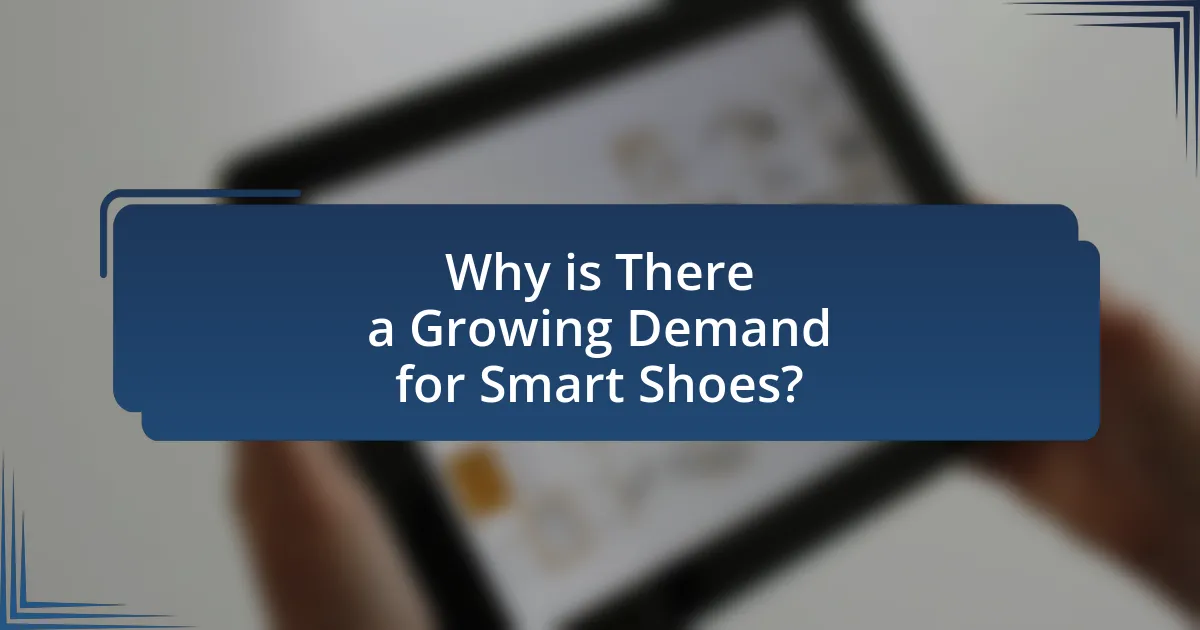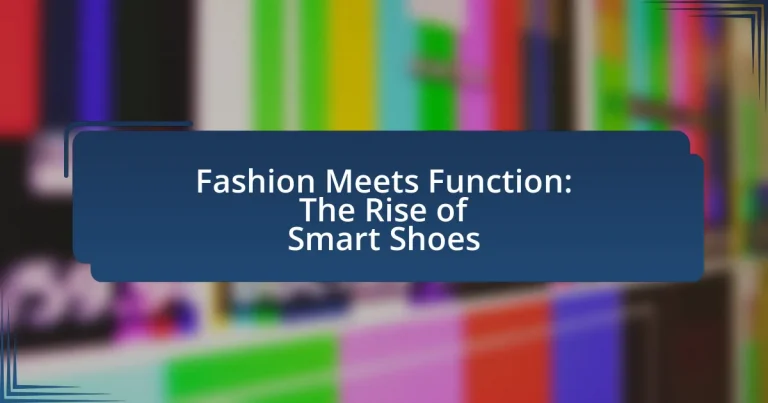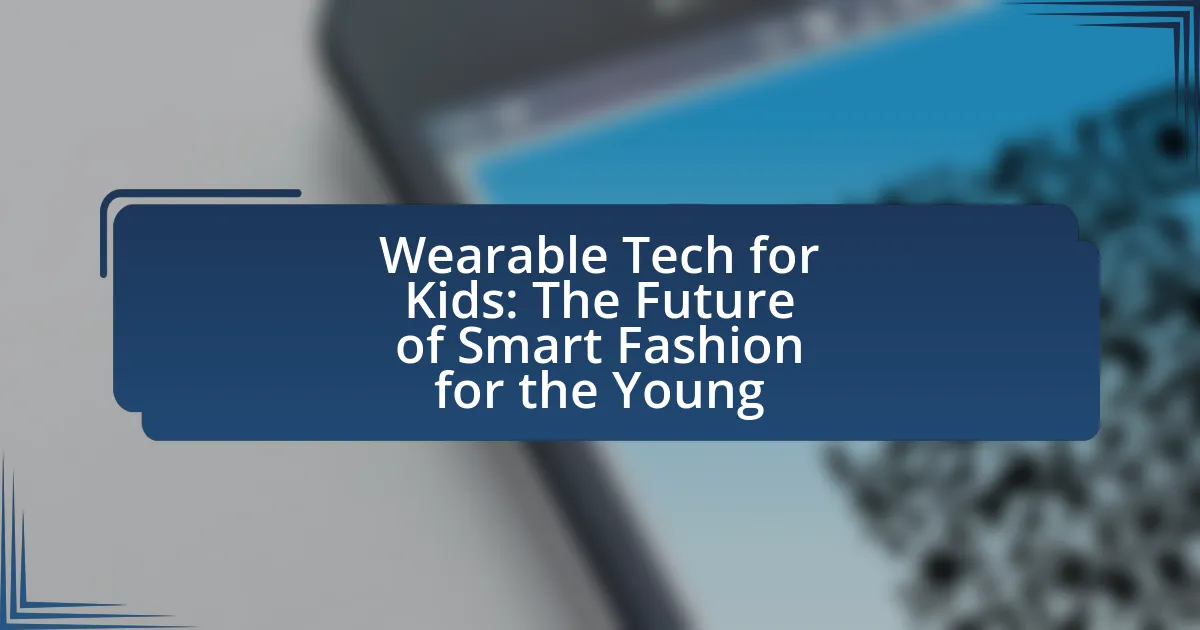Smart shoes are technologically advanced footwear that combines fashion with functionality, featuring capabilities such as fitness tracking, health monitoring, and navigation assistance. This article explores the various technologies integrated into smart shoes, including sensors and connectivity, which enhance user experience by providing real-time data on physical activity and performance metrics. It also examines the growing demand for smart shoes driven by health awareness, fashion trends, and consumer preferences for multifunctional products. Additionally, the article addresses challenges faced by the smart shoe market, such as high production costs and consumer misconceptions, while offering insights into best practices for selecting and maintaining these innovative footwear options.

What are Smart Shoes and How Do They Integrate Fashion and Function?
Smart shoes are footwear equipped with technology that enhances functionality, such as fitness tracking, navigation, and health monitoring. These shoes integrate fashion and function by combining stylish designs with advanced features like sensors and connectivity to smartphones, allowing users to maintain a fashionable appearance while benefiting from practical applications. For instance, brands like Nike and Adidas have developed smart shoes that not only look appealing but also provide data on performance metrics, demonstrating that aesthetic appeal can coexist with technological innovation in the footwear industry.
What technologies are incorporated into smart shoes?
Smart shoes incorporate various technologies such as sensors, Bluetooth connectivity, and GPS tracking. These sensors can monitor metrics like steps taken, distance traveled, and even the wearer’s posture. Bluetooth connectivity allows the shoes to sync with smartphones or other devices for data analysis and feedback. GPS tracking enables real-time location monitoring, which can be useful for navigation and fitness tracking. The integration of these technologies enhances user experience by providing valuable insights into physical activity and health metrics.
How do sensors enhance the functionality of smart shoes?
Sensors enhance the functionality of smart shoes by providing real-time data on various metrics such as foot pressure, gait analysis, and activity tracking. These sensors enable features like step counting, calorie tracking, and injury prevention by analyzing the user’s movement patterns. For instance, pressure sensors can detect uneven weight distribution, alerting users to potential issues that could lead to injuries. Additionally, accelerometers and gyroscopes in smart shoes can monitor running form and provide feedback for improvement, thereby enhancing athletic performance. This integration of sensors transforms traditional footwear into advanced health and fitness tools, making them valuable for both casual users and athletes.
What role does connectivity play in smart shoe technology?
Connectivity is essential in smart shoe technology as it enables real-time data transmission between the shoes and connected devices, such as smartphones or fitness trackers. This connectivity allows users to monitor metrics like distance traveled, calories burned, and foot pressure, enhancing the overall user experience. For instance, smart shoes equipped with Bluetooth technology can sync with mobile applications to provide personalized feedback and performance analytics, which can lead to improved athletic performance and injury prevention. The integration of connectivity in smart shoes exemplifies the convergence of fashion and functionality, making them not only stylish but also a valuable tool for fitness enthusiasts.
How do smart shoes differ from traditional footwear?
Smart shoes differ from traditional footwear primarily through their integration of technology, enabling features such as fitness tracking, navigation assistance, and connectivity to smartphones. Unlike traditional shoes, which focus solely on comfort and style, smart shoes utilize sensors and software to monitor physical activity, providing real-time data on metrics like distance traveled and calories burned. For example, brands like Nike and Under Armour have developed smart shoes that connect to apps, allowing users to analyze their performance and set fitness goals, showcasing a significant advancement in functionality compared to conventional footwear.
What are the key design elements that merge style with technology?
The key design elements that merge style with technology in smart shoes include aesthetics, functionality, and user experience. Aesthetics involve sleek, modern designs that appeal to fashion-conscious consumers, often incorporating trendy colors and materials. Functionality encompasses integrated technology such as sensors for tracking performance metrics, Bluetooth connectivity for syncing with apps, and adaptive features like self-lacing mechanisms. User experience focuses on comfort and ease of use, ensuring that the technology enhances rather than complicates the wearer’s experience. For instance, brands like Nike and Adidas have successfully combined these elements, resulting in products that not only perform well but also attract consumers with their stylish designs.
How do smart shoes cater to different consumer needs?
Smart shoes cater to different consumer needs by integrating technology that enhances functionality, comfort, and performance. For instance, fitness enthusiasts benefit from features like activity tracking, heart rate monitoring, and GPS navigation, which help them optimize their workouts. Additionally, smart shoes designed for individuals with specific health concerns, such as diabetes, often include sensors that monitor foot pressure and temperature to prevent injuries. Furthermore, customization options allow consumers to select styles and features that align with their personal preferences, ensuring that both aesthetic and practical needs are met. This adaptability is supported by market research indicating that the global smart footwear market is projected to grow significantly, reflecting increasing consumer demand for multifunctional products.

Why is There a Growing Demand for Smart Shoes?
There is a growing demand for smart shoes due to their integration of technology that enhances user experience and functionality. Smart shoes offer features such as fitness tracking, health monitoring, and connectivity with smartphones, appealing to health-conscious consumers and tech enthusiasts. According to a report by Grand View Research, the global smart footwear market is expected to reach $2.5 billion by 2025, driven by increasing awareness of health and fitness, as well as advancements in wearable technology. This trend reflects a shift towards products that combine style with practical benefits, making smart shoes a desirable choice in the fashion and fitness markets.
What factors are driving the popularity of smart shoes?
The popularity of smart shoes is driven by advancements in technology, health tracking capabilities, and consumer demand for multifunctional products. Technological innovations, such as embedded sensors and connectivity features, allow smart shoes to monitor physical activity, track fitness metrics, and provide real-time feedback to users. Health tracking capabilities appeal to a growing health-conscious demographic, as studies show that wearable technology can enhance fitness engagement and promote healthier lifestyles. Additionally, the increasing consumer preference for products that combine style with functionality further fuels the demand for smart shoes, as they offer both aesthetic appeal and practical benefits.
How has the rise of fitness tracking influenced smart shoe development?
The rise of fitness tracking has significantly influenced smart shoe development by driving the integration of advanced sensors and technology into footwear. As consumers increasingly prioritize health and fitness, manufacturers have responded by incorporating features such as step counting, distance tracking, and performance analytics into smart shoes. For instance, companies like Nike and Adidas have developed shoes equipped with sensors that sync with fitness apps, allowing users to monitor their activity levels in real-time. This trend is supported by market research indicating that the global smart shoe market is projected to grow substantially, reflecting consumer demand for footwear that enhances fitness tracking capabilities.
What role does consumer awareness of health and wellness play?
Consumer awareness of health and wellness plays a crucial role in driving demand for smart shoes that promote physical well-being. As consumers become more informed about the benefits of health-conscious products, they increasingly seek footwear that integrates technology to monitor fitness metrics, enhance comfort, and support overall health. For instance, a study by the International Journal of Environmental Research and Public Health found that 70% of consumers are willing to invest in wearable technology that tracks health indicators, indicating a strong correlation between health awareness and purchasing decisions in the footwear market. This awareness not only influences consumer choices but also encourages manufacturers to innovate and prioritize health-related features in their products.
How are fashion trends impacting the smart shoe market?
Fashion trends are significantly influencing the smart shoe market by driving consumer demand for stylish and technologically advanced footwear. As consumers increasingly prioritize aesthetics alongside functionality, brands are integrating fashionable designs with smart features, such as fitness tracking and connectivity. For instance, a report from Allied Market Research indicates that the global smart shoe market is projected to reach $1.4 billion by 2025, largely due to the rising popularity of athleisure and the demand for wearable technology that complements modern lifestyles. This trend showcases how fashion-forward designs can enhance the appeal of smart shoes, making them more attractive to a broader audience.
What styles are currently trending in the smart shoe industry?
Currently, the trending styles in the smart shoe industry include fitness tracking sneakers, self-lacing shoes, and augmented reality footwear. Fitness tracking sneakers, such as those from Nike and Adidas, integrate sensors to monitor physical activity and provide real-time feedback. Self-lacing shoes, popularized by brands like Nike’s Adapt series, offer convenience and customization through app connectivity. Augmented reality footwear, seen in collaborations like Puma’s partnership with Snapchat, enhances user experience by integrating digital elements into the physical shoe. These trends reflect a growing consumer demand for functionality combined with innovative design in the smart shoe market.
How do collaborations between tech companies and fashion brands shape the market?
Collaborations between tech companies and fashion brands shape the market by driving innovation and creating new product categories, such as smart shoes. These partnerships leverage technology to enhance functionality, offering features like fitness tracking and connectivity, which appeal to consumers seeking both style and utility. For instance, the collaboration between Nike and Apple led to the development of the Nike+ system, integrating athletic footwear with digital tracking, which significantly influenced consumer behavior and market trends in the athletic wear sector. Such collaborations not only expand the product offerings but also attract a broader audience, merging the interests of tech-savvy consumers with fashion enthusiasts, thereby reshaping market dynamics.

What Challenges Do Smart Shoes Face in the Market?
Smart shoes face several challenges in the market, including high production costs, limited consumer awareness, and competition from traditional footwear. High production costs arise from the integration of advanced technology, which can lead to retail prices that deter potential buyers. Limited consumer awareness is a significant barrier, as many consumers are unfamiliar with the benefits and functionalities of smart shoes, resulting in a lack of demand. Additionally, competition from established brands in the traditional footwear market makes it difficult for new entrants to gain market share. According to a report by Grand View Research, the global smart footwear market is projected to grow, but it must overcome these challenges to achieve widespread adoption.
What are the common technical issues associated with smart shoes?
Common technical issues associated with smart shoes include connectivity problems, battery life limitations, and sensor inaccuracies. Connectivity issues often arise due to Bluetooth or Wi-Fi failures, which can disrupt data transmission between the shoes and connected devices. Battery life limitations can lead to frequent recharging, impacting usability, as many smart shoes require regular power to maintain functionality. Additionally, sensor inaccuracies can result in incorrect data readings, such as step counts or distance measurements, which undermine the reliability of the smart shoe’s performance. These issues have been documented in various user reviews and technical assessments, highlighting the need for ongoing improvements in smart shoe technology.
How do battery life and durability affect user experience?
Battery life and durability significantly enhance user experience by ensuring that smart shoes remain functional and reliable over extended periods. Users expect smart shoes to provide consistent performance without frequent recharging or wear-related failures. For instance, a study by the Consumer Technology Association found that 70% of users prioritize battery longevity in wearable technology, indicating that longer battery life directly correlates with user satisfaction. Additionally, durable materials prevent damage from daily wear, which is crucial for maintaining the shoe’s functionality and aesthetic appeal. Therefore, effective battery life and robust durability are essential for a positive user experience in smart shoes.
What are the challenges in maintaining software updates for smart shoes?
Maintaining software updates for smart shoes presents several challenges, including device compatibility, user engagement, and security vulnerabilities. Device compatibility issues arise because smart shoes may utilize various hardware components and operating systems, making it difficult to create a one-size-fits-all update. User engagement is critical, as many users may not regularly connect their shoes to update software, leading to outdated functionalities. Additionally, security vulnerabilities can emerge if updates are not implemented promptly, exposing users to potential data breaches or unauthorized access. These challenges necessitate a robust strategy for effective software maintenance in the evolving landscape of smart footwear.
How do consumer perceptions impact the adoption of smart shoes?
Consumer perceptions significantly influence the adoption of smart shoes by shaping their acceptance and willingness to purchase. Positive perceptions, such as viewing smart shoes as innovative and beneficial for health or performance, can lead to increased interest and sales. For instance, a study published in the Journal of Consumer Research found that consumers are more likely to adopt wearable technology when they perceive it as enhancing their lifestyle and providing tangible benefits. Conversely, negative perceptions, such as concerns about privacy, reliability, or the complexity of use, can hinder adoption rates. Research indicates that 60% of potential users cite concerns over data security as a barrier to adopting smart wearable devices, including smart shoes. Thus, consumer perceptions directly impact both the market potential and the actual uptake of smart shoes.
What misconceptions exist about the functionality of smart shoes?
Misconceptions about the functionality of smart shoes include the belief that they are solely fitness trackers and that they require constant charging. While smart shoes do often incorporate fitness tracking features, they also offer functionalities such as navigation assistance, health monitoring, and integration with smart devices. Additionally, many smart shoes are designed with long-lasting battery life, often lasting weeks on a single charge, which counters the notion that they need frequent recharging. This understanding is supported by advancements in battery technology and energy-efficient designs in the footwear industry.
How can brands effectively communicate the benefits of smart shoes?
Brands can effectively communicate the benefits of smart shoes by highlighting their unique features, such as fitness tracking, customizable settings, and enhanced comfort. For instance, brands can showcase how smart shoes monitor physical activity and provide real-time feedback, which appeals to health-conscious consumers. Additionally, using testimonials and case studies can illustrate the practical advantages, such as improved performance and injury prevention, thereby reinforcing the value proposition. Research indicates that 70% of consumers are more likely to purchase products that have clear, demonstrable benefits, making it essential for brands to present data and user experiences that validate the effectiveness of smart shoes.
What are the best practices for choosing and using smart shoes?
The best practices for choosing and using smart shoes include assessing comfort, ensuring compatibility with devices, and evaluating features that meet personal needs. Comfort is crucial, as smart shoes should fit well and provide adequate support for daily activities. Compatibility with smartphones or fitness trackers is essential to utilize the shoe’s features effectively, such as tracking steps or monitoring health metrics. Additionally, users should consider specific features like GPS tracking, activity monitoring, or customizable settings that align with their lifestyle. Research indicates that 60% of consumers prioritize comfort and functionality when selecting smart footwear, highlighting the importance of these factors in the decision-making process.
How can consumers select the right smart shoes for their lifestyle?
Consumers can select the right smart shoes for their lifestyle by assessing their specific needs, such as fitness tracking, comfort, and style preferences. For instance, individuals who prioritize fitness may choose smart shoes with built-in sensors for tracking steps and calories, while those focused on fashion might look for designs that complement their wardrobe. Additionally, consumers should consider the shoe’s compatibility with mobile apps for enhanced functionality, as many smart shoes offer features like personalized coaching or performance analytics. Research indicates that 70% of consumers value both functionality and aesthetics in footwear, highlighting the importance of balancing these factors when making a selection.
What maintenance tips can enhance the longevity of smart shoes?
To enhance the longevity of smart shoes, regularly clean them with a damp cloth and mild soap to remove dirt and sweat, as this prevents material degradation. Additionally, storing smart shoes in a cool, dry place away from direct sunlight helps maintain their structural integrity and electronic components. Using a protective spray designed for the shoe material can also shield against moisture and stains, further extending their lifespan. Regularly checking and updating the software of the embedded technology ensures optimal performance and longevity.





